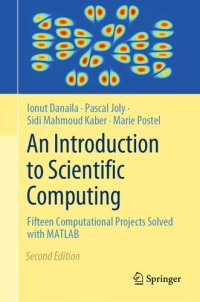
Ebook: An Introduction to Scientific Computing : Fifteen Computational Projects Solved with MATLAB
Author: Ionut Danaila, Pascal Joly, Sidi Mahmoud Kaber, Marie Postel
- Genre: Computers // Software: Systems: scientific computing
- Year: 2023
- Publisher: Springer International Publishing
- Edition: 2
- Language: English
- epub
This book demonstrates scientific computing by presenting twelve computational projects spanning a broad spectrum of disciplines including Fluid Mechanics, Chemistry, Elasticity, Thermal Science, Computer Aided Design, Signal and Image Processing and more. Each project guides the reader through typical steps of scientific computing, from physical and mathematical description of the problem, to numerical formulation and programming and finally to critical discussion of results. The text teaches practical computational methods which are not usually available in basic textbooks: numerical checking of accuracy or stability, choice of boundary conditions, effective solving of linear systems, comparison to exact solutions and more. Programming techniques such as vectorial programming and memory storage optimization are addressed, and chapter-ending references form a guide for further reading. The final section of each project contains the solutions to proposed exercises and guides the reader in using the MATLAB scripts available online.
We conclude by saying a few words about the programs provided in this book. They are written in MATLAB, a widely used software environment for scientific computing produced by The MathWorks Inc. We consider that an interpreted language (such as MATLAB, SCILAB, and OCTAVE) is the ideal framework to start a scientific programming activity. Debugging is very simple and the wide variety of available numerical tools (for solving linear systems, integrating ordinary differential equations, etc.) allows one to concentrate on the main features of the resolution algorithm. The highly versatile graphical interface is also very important for easy visualization of the obtained results.
Our programs are written with a general concern for simplicity and efficiency on ordinary personal computers; program lines are commented in what we hope is sufficient detail for the reader to follow mathematical developments. Programming tricks are discussed in the text when they seem to be of general interest. Projects 11 and 12 are also provided with more elaborate versions of the programs, using interactive graphical user interfaces. The reader should try to modify these programs to test different suggested run cases or extensions of the projects. We believe that experience with these simple programs will be valuable in writing numerical codes using compiled languages (such as Fortran, C, or C++) to solve real industrial problems on mainframe computers.
We conclude by saying a few words about the programs provided in this book. They are written in MATLAB, a widely used software environment for scientific computing produced by The MathWorks Inc. We consider that an interpreted language (such as MATLAB, SCILAB, and OCTAVE) is the ideal framework to start a scientific programming activity. Debugging is very simple and the wide variety of available numerical tools (for solving linear systems, integrating ordinary differential equations, etc.) allows one to concentrate on the main features of the resolution algorithm. The highly versatile graphical interface is also very important for easy visualization of the obtained results.
Our programs are written with a general concern for simplicity and efficiency on ordinary personal computers; program lines are commented in what we hope is sufficient detail for the reader to follow mathematical developments. Programming tricks are discussed in the text when they seem to be of general interest. Projects 11 and 12 are also provided with more elaborate versions of the programs, using interactive graphical user interfaces. The reader should try to modify these programs to test different suggested run cases or extensions of the projects. We believe that experience with these simple programs will be valuable in writing numerical codes using compiled languages (such as Fortran, C, or C++) to solve real industrial problems on mainframe computers.
Download the book An Introduction to Scientific Computing : Fifteen Computational Projects Solved with MATLAB for free or read online
Continue reading on any device:

Last viewed books
Related books
{related-news}
Comments (0)